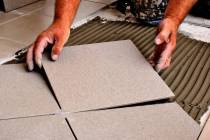Ins, outs of painting the exterior of your house
Imagining the colors of a child’s room or brainstorming bold ideas for an accent wall are pretty common thoughts that swirl in the minds of DIY-obsessed homeowners. These interior paint jobs add character and personalize a home.
On the other hand, painting a house’s exterior can sometimes catch an owner by surprise. Maybe you spot some unexpected fading on the side of the home or, even worse, an HOA notice with a hard deadline says it’s time for a refresh.
For homeowners, between evaluating bids, picking colors and researching best practices, an exterior paint job can bring plenty of unknown territories. Here are a few factors to consider when it’s time to paint the outside of your home.
Contractors, bids
Most people who need to paint their home’s exterior will not choose the DIY route – and for good reason. The job likely requires buying or renting an airless sprayer, a pressure washer and plenty of masking equipment to capture overspray, not to mention ladders and maybe even scaffolding if your home has two or three stories. If you buy the equipment, the price tag can run up to several thousand dollars pretty quickly for decent equipment, about as much as you’d pay for a professional job on a smaller home anyway.
The rule of three — or getting three quotes — is a good general rule of thumb. Yes, do your online research and check the Better Business Bureau before calling. And more importantly, remember all quotes and bids look very different, and it’s often the details left out of them that can come back to bite a homeowner.
“One of the biggest things you look for in a bid is transparency,” said Brian Cho, general manager of Nevada Painting Company, a local painting contractor. “The first thing to check is what’s being put on the home, materialwise.”
Knowing the brand is not enough, asserts Cho. Even the most reputable brands like Sherwin-Williams, Dunn-Edwards and others, all have lower and higher-grade products. Some painters may opt for a contractor-grade paint, the cheapest, most watered-down, paint available, Cho said. It’s important to know the brand and specific line used.
“It’s the digital age. I tell people to Google that specific line and do some research,” he added.
Cho’s company uses Sherwin-Williams’ Duration, a top-of-the-line product, for some jobs. For those high-end paint
projects, because of the Duration formula, he can offer a 10-year warranty. Most contractors will likely offer a lower, middle and higher-grade option, based on price and the line of paint being used.
“The grade of the paint dictates the warranty,” Cho added.
Understanding prep
Whether you’re doing the job yourself or not, paint prep is the key to quality work. The general steps for paint prep include power washing the home, patching holes and cracks, then properly masking off trim and areas not to be painted before painting.
Some estimates may not include pressure washing. Others only give vague descriptions of prep work. The more detail for all processes, the better, Cho said.
“You’ll run into contractors who won’t pressure wash. The paint will have a hard time adhering if the surface isn’t clean,” he said.
Working with HOAs
If you live in a community with an HOA, you’ll need to start communication with the organization before work commences. If you were sent a notice, it’s important to get a date stamped estimate when looking for contractors, Cho added. The date stamped document provides proof to the HOA that the homeowner is working on the problem in case there are delays in getting the work done.
In most situations, color schemes must be approved by the HOA. Veering from color scheme options offered by an HOA will also likely require board approval.
Some HOA’s have become more lenient and will allow a homeowner to use different colors from different schemes. For example, if there are 10 schemes offered, a homeowner may like two colors from, say, the third scheme and one from the sixth scheme. Board approval will likely be required for this change, but more and more HOAs are offering such flexibility, Cho said.
Thinking through color options
If you’re dealing with an HOA, you’ll likely see a lot of beige and tan options for the body of the home. However, that doesn’t mean the property’s eaves, trim areas and window or garage pop-outs can’t add unique character to the home, says Sara McLean, editor for Dunn-Edwards’ specs+spaces design blog.
McLean encourages people to consider their landscape when choosing a color. If the home has greenery around it, like shrubs and grass, the body of the home should have a lighter color. That lighter color can be contrasted with darker or brighter accents on trim or pop-outs.
“Those elements that break up the (lighter) color may be a darker shutter color or a different door color,” she said.
If the yard is primarily xeriscape, avoid white or very light colors on the body of the home; it might create a “wash-out” effect, McLean explained.
For those who live in a downtown midcentury modern home, McLean encourages owners to embrace the boldness of the period, if possible. Grays are popular for these homes, with plenty of interesting pops of color.
“The front door, that’s where you’ll find that quirky character of midcentury moderns,” she added.
In the ’50s, bright colors like “bubble gum pink” could be found on these front doors. Today’s approach is slightly more toned down, McLean added. You’ll see more pinks with a hint of peach, blues and rust oranges.
Whether your home is older or newer, if you’re at a loss as to which color to choose, a color consultant appointment may be a couple hundred dollars well spent, the expert said.
“I think people are hesitant to hire services like that. But what’s $150 or $200 that could be well worth it if you don’t have to (paint again),” she noted.
Other factors
There are a few other factors to consider when painting your exterior. If your home has stucco and you feel you can do the job with a roller instead of a paint sprayer, you may be in for a rude awakening.
Regardless of how thick the roller may be, adequately covering the surface could prove challenging. If this is a road you are strongly considering, you may test a small section in an inconspicuous area of the home, first.
When it comes to patching cracks and holes during the prep phase, whether you are doing it yourself or have hired a contractor, a good general rule of thumb for a crack that requires patching is if a business card can fit into it. An elastomeric patching product should be used. Elastomeric patches bring flexibility and durability to keep the crack filled even as the house continues to settle.
Cho also warns that warranties cover the coating’s premature failure, which can include cracking and peeling during the warranty window. Warranties, however, do not cover paint fade. Darker colors, which tend to fade sooner than lighter ones in the extreme desert heat, may have a shorter warranty, or not one at all, Cho warned. Ask a painting contractor about the limitations of a warranty before the job starts.


























